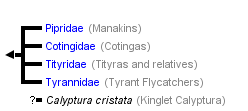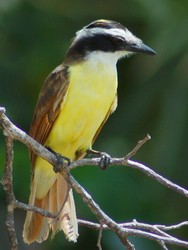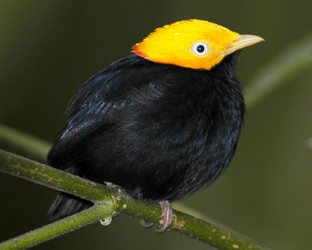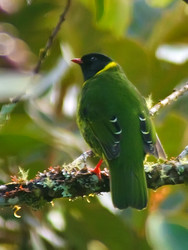Tyranni
John Harshman


This tree diagram shows the relationships between several groups of organisms.
The root of the current tree connects the organisms featured in this tree to their containing group and the rest of the Tree of Life. The basal branching point in the tree represents the ancestor of the other groups in the tree. This ancestor diversified over time into several descendent subgroups, which are represented as internal nodes and terminal taxa to the right.

You can click on the root to travel down the Tree of Life all the way to the root of all Life, and you can click on the names of descendent subgroups to travel up the Tree of Life all the way to individual species.
For more information on ToL tree formatting, please see Interpreting the Tree or Classification. To learn more about phylogenetic trees, please visit our Phylogenetic Biology pages.
close boxDiscussion of Phylogenetic Relationships
Several clades within Tyranni are clearly established: Pipridae (manakins), Tityridae (tityras), Cotingidae (cotingas), and Tyrannidae (tyrant flycatchers). But relationships among them are contradictory in different analyses, and no resolution is strongly supported in any analysis (Barker et al. 2002, 2004; Johansson et al. 2002; Chesser 2004, Ohlson et al. 2008, Tello et al. 2009). However, the last two references, especially, have made considerable progress in consolidating these four clades (though some species have changed allegiance) and every species but one can now be placed in its proper group with confidence. That species, Calyptura cristata, remains a mystery. Until recently thought extinct, it has never been genetically sampled, and it has been linked at various times to tyrannids, tityrids, cotingids, and piprids.The group here called Tyranni has been given various other, though similar, names by other workers, Tyrannides and Tyrannida being the commonest. The distinctions are arbitrary.
References
Barker, F. K., G. F. Barrowclough, and J. G. Groth. 2002. A phylogenetic hypothesis for passerine birds; Taxonomic and biogeographic implications of an analysis of nuclear DNA sequence data. Proc. R. Soc. Lond. B 269:295-308.
Barker, F. K., A. Cibois, P. Schikler, J. Feinstein, and J. Cracraft. 2004. Phylogeny and diversification of the largest avian radiation. Proc. Natl. Acad. Sci. USA 101:11040-11045.
Chesser, R. T. 2004. Molecular systematics of New World suboscine birds. Mol. Phylogen. Evol. 32:11-24.
Ericson, P. G. P., D. Zuccon, J. I. Ohlson, U. S. Johansson, H. Alvarenga, and R. O. Prum. 2006. Higher level phylogeny and morphological evolution of tyrant flycatchers, cotingas, manakins and their allies (Aves: Tyrannida). Molecular Phylogenetics and Evolution 40:471–483.
Johansson, U. S., M. Irestedt, T. J. Parsons, and P. G. P. Ericson. 2002. Basal phylogeny of the Tyrannoidea based on comparisons of cytochrome b and exons of nuclear c-myc and RAG-1 genes. Auk 119:984-995.
Lanyon, S.M. 1985. Molecular perspective on higher-level relationships in the Tyrannoidea (Aves). Systematic Zoology 34:404–18.
Ohlson, J. I., R. O. Prum, and P. G. P. Ericson. 2007. A molecular phylogeny of the cotingas (Aves : Cotingidae). Molecular Phylogenetic and Evolution 42(1):25-37.
Prum, R. O. 1990. A test of the monophyly of the manakins (Pipridae) and of the cotingas (Cotingidae) based on morphology. Occasional Papers of The Museum of Zoology, The University of Michigan 723:1–44.
Ridgely, R. S. and G. Tudor. 1994. The Birds of South America. Volume 2. The Suboscine Passerines. University of Texas, Austin.
Title Illustrations

| Scientific Name | Pitangus sulphuratus |
|---|---|
| Location | Puerto Aventuras, Quintana Roo, Mexico |
| Specimen Condition | Live Specimen |
| Source | Grande Kiskadi / Great kiskadee |
| Source Collection | Flickr |
| Image Use |
 This media file is licensed under the Creative Commons Attribution-NonCommercial License - Version 2.0. This media file is licensed under the Creative Commons Attribution-NonCommercial License - Version 2.0.
|
| Copyright | © 2006 Isidro Vila Verde |
| Scientific Name | [Pipra] erythrocephala |
|---|---|
| Location | captive at North Carolina Zoo |
| Specimen Condition | Live Specimen |
| Source | Golden-headed Manakin |
| Source Collection | Flickr |
| Image Use |
 This media file is licensed under the Creative Commons Attribution-NonCommercial-NoDerivs License - Version 2.0. This media file is licensed under the Creative Commons Attribution-NonCommercial-NoDerivs License - Version 2.0.
|
| Copyright | © 2007 Valerie |
| Scientific Name | Pipreola riefferii |
|---|---|
| Location | Owlet Lodge, Abra Patricia, Amazonas dept., Peru |
| Comments | Fairly common along east slope of Andes, 1700-2900m. These were quite common in the grounds of Owlet Lodge. |
| Specimen Condition | Live Specimen |
| Source | Green-and-black Fruiteater (Pipreola riefferii) |
| Source Collection | Flickr |
| Image Use |
 This media file is licensed under the Creative Commons Attribution-NonCommercial License - Version 2.0. This media file is licensed under the Creative Commons Attribution-NonCommercial License - Version 2.0.
|
| Copyright | © 2009 David Cook Wildlife Photography |
About This Page
Correspondence regarding this page should be directed to John Harshman at
Page copyright © 2009
 Page: Tree of Life
Tyranni.
Authored by
John Harshman.
The TEXT of this page is licensed under the
Creative Commons Attribution-NonCommercial License - Version 3.0. Note that images and other media
featured on this page are each governed by their own license, and they may or may not be available
for reuse. Click on an image or a media link to access the media data window, which provides the
relevant licensing information. For the general terms and conditions of ToL material reuse and
redistribution, please see the Tree of Life Copyright
Policies.
Page: Tree of Life
Tyranni.
Authored by
John Harshman.
The TEXT of this page is licensed under the
Creative Commons Attribution-NonCommercial License - Version 3.0. Note that images and other media
featured on this page are each governed by their own license, and they may or may not be available
for reuse. Click on an image or a media link to access the media data window, which provides the
relevant licensing information. For the general terms and conditions of ToL material reuse and
redistribution, please see the Tree of Life Copyright
Policies.
- First online 02 August 2006
- Content changed 28 November 2009
Citing this page:
Harshman, John. 2009. Tyranni. Version 28 November 2009 (under construction). http://tolweb.org/Tyranni/67994/2009.11.28 in The Tree of Life Web Project, http://tolweb.org/












 Go to quick links
Go to quick search
Go to navigation for this section of the ToL site
Go to detailed links for the ToL site
Go to quick links
Go to quick search
Go to navigation for this section of the ToL site
Go to detailed links for the ToL site